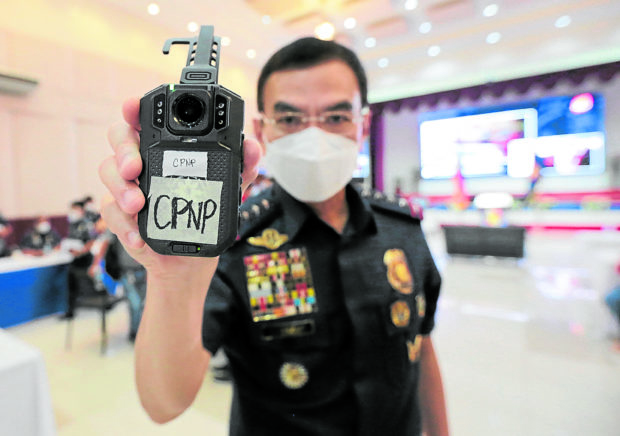
Philippine National Police (PNP) Chief Gen. Guillermo Eleazar shows the Body Worn Camera System during its launching at a press conference on June 4, 2021, at Camp Crame in Quezon City. INQUIRER FILE PHOTO / GRIG C. MONTEGRANDE
MANILA, Philippines — Police officers doing operations such as serving arrest warrants would now have to use body-worn cameras (BWCs), Philippine National Police (PNP) chief Gen. Guillermo Eleazar said on Tuesday.
In a statement, Eleazar said that the Directorate for Operations has already issued a memorandum containing the general protocols for using BWCs or alternative recording devices (ARDs) in police operations.
This is in line with the Supreme Court (SC) Administrative Matter 21-06-08-SC which states that failure to comply with the regulations would make the evidence seized during an operation inadmissible for the court.
“Ngayong epektibo na ang mga alituntunin na inilabas ng ating Korte Suprema tungkol sa paggamit ng body-worn cameras, agad naglabas ng kautusan ang inyong PNP ng Memorandum Order sa lahat ng ating commanders na sumunod sa mga patakarang ito,” Eleazar said.
(Now that the regulations released by our Supreme Court regarding the use of body-worn cameras are effective, the PNP immediately released a Memorandum Order for our commanders to follow these rules.)
“Ang inyong PNP ang nagsagawa ng inisyatibo para humingi ng tulong sa Korte Suprema para sa malinaw na alituntunin sa paggamit ng mga body-worn cameras kaya walang dahilan para hindi naming sundin ito,” he added.
(It is the PNP which took the initiative to seek help from the Supreme Court for a clear rules and regulations on the use of body-worn cameras, so there is no reason for us not to follow it.)
Last July 10, SC said that law enforcement officers are required to use BWCs when implementing search and arrest warrants — and file a motion before the courts to ask for permission to use ARDs if a body-worn camera is not yet available.
Afterward, the PNP formulated its own technical working group to incorporate the SC guidelines into their own manual.
READ: SC: Body cameras now mandatory when serving search, arrest warrants | PNP adopts SC guidelines on use of body cams
The use of BWCs is seen to increase transparency within police operations, as PNP and other law enforcement agencies have been accused of several lapses in their operational procedures, especially in the arrest of alleged communist rebels and during the war against illegal drugs.
Since the general protocols provide that the BWCs or the ARDs must never be turned off at any time during the operation, Eleazar said that this also provides some sort of security for law enforcers — protection from allegations of wrongdoings.
As of now though, Eleazar admitted that the PNP’s body-worn cameras are not yet enough to provide every officer with such a device.
“Ito ay hindi lamang para sa proteksyon ng mga karapatan ng ating mga kababayan kundi proteksyon din ng aming hanay laban sa mga maling haka-haka at alegasyon sa isinasagawa naming operasyon,” he explained.
(This is not only meant to protect the rights of the people, but also to protect our ranks from the wrongful speculations and allegations regarding our operations.)
“Hindi sapat ang aming [We do not yet have enough] body-worn cameras but in the spirit of transparency and accountability, I trust that our commanders will find ways to comply with the Supreme Court’s guidelines on the use of body-worn cameras,” he added.
Eleazar also assured the public that the general guidelines adhere to the SC document regarding the issue.
“The memorandum also requires police operatives to, upon return of warrant, submit a copy of the video to the court along with an affidavit attesting to the facts and authenticity of the recording,” he said.
“Nakasaad din dito na kailangang magpaliwanag sa korte ng mga operatiba sakaling hindi nila sundin ang requirement na paggamit ng BWC o ARD sa kanilang operasyon,” he added.
(It is also stated here that operatives have to explain to the courts if ever they need to refrain from following the requirements on the use of BWCs and ARDs in their operations.)